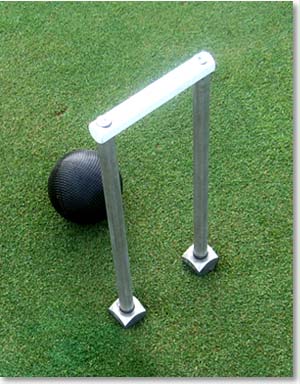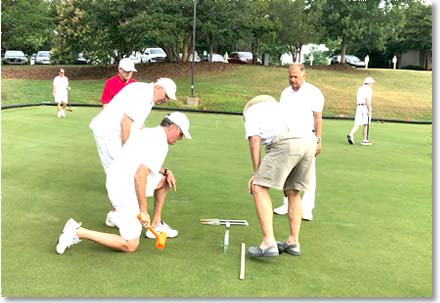
|
Back to |
| The Front Page |
| The Game |
|
The Quadway Hoop is available everywhere |
||||||
|
by Bob Alman with thanks to Damon Bidencope and David Maloof for both words and photos
|
||||||
|
||||||
When Damon Bidencope sent us a detailed report on the first event-based testing of the Quadway in America, and told us that David Maloof had bought the hoops for his Linville Ridge club, that was the signal for a new article on the Quadway, now "available" in all the croquet-playing countries. Since we reviewed the Quadway in 2014, it has undergone many tests in major competitions, beginning in New Zealand, where it was developed. It has achieved wide use in Australia, and the English Croquet Association has recently purchased six sets. There is solid consensus that the Quadway offers the most difficult challenge for top-level players; and the ease of re-setting the width of the hoops may make the relatively expensive equipment a practical purchase for many clubs.
It happened at a regional Golf Croquet event at Tega Cay in South Carolina, with teams from North Carolina, South Carolina, Florida, and Georgia. The Quadway hoops were provided by Simon Jenkins, the US agent for both Quadway hoops and Terminator mallets.
The trial was significant because the predominant construction method for courts in the US is sand-based or a sand-based root zone mix--which is not the case in most other croquet-playing countries. The question, in Damon's words, was "How well do these Kiwi-developed hoops play in our American sand pit?"
It turns out that they play very well, but it was the ease of resetting the hoops for different widths that sold David Maloof, top-ranked American croquet pro and recent finalist in the world championship, on buying them for his summer venues in the North Carolina mountains.

|
The assessment that it is the most difficult hoop to run has been thoroughly verified. That fact alone qualifies it as the ultimate "test" of relative skill in major events for top-ranked players. (That issue can be effectively addressed only in three categories: hoops, terrain, and "advanced" rules that call for lift shots.)
The sets are expensive and costly to ship from New Zealand. But their labor-saving and accuracy attributes may justify their purchase by local clubs.

|
||||||||||||||||
| David Maloof compares here the three-finned Super Hoop and the Quadway: their "footprint" on the lawns, and their relative size. | ||||||||||||||||

|
| David Maloof, croquet pro and recent finalist in the world championship, holds up the two essential elements of the Quadway system: the dibber that makes the holes uniform, and the adjustable hoop that drops into it. |
The dibber tool, an essential part of the system, must be used to made the precise hole to receive the rectangular carrot of the hoop legs. The dibber eliminates the need to pound each wicket into place. This pounding in of hoops is the traditional way they have been set, and over time it results in bowing the legs out and marring the finish of the cross bar.

|
| The dibber standing on Maloof's lawn is about to be pounded into the lawn to create a hole for the Quadway. The other pics show a hoop disassembled for readjusting the hoops legs to a smaller or wider clearance. |

The dibber also makes it easy to set all the hoops with uniform widths and within tournament specification in a snap. (By eliminating the outside pressure from clamping, the hoop width tends to remain constant, as the current practice at most facilities with conventional hoops places pressure from a clamp that releases and causes the width to change or revert to the manufactured shape over the course of a day.)
David Maloof reported the performance of the hoops "surprisingly good in the wet soil." (There had been lots of rain on the courts.) "Even when the hoops loosened a bit, they still rejected mediocre shots. I had tested the hoops in soft soil playing Association Croquet, and my first impression was that they were not much more difficult than our 3-fin hoops, (the so-called "Super Hoops" conventionally set for top-level events on America's sand-based courts) but then I noticed how our club members were struggling with them. The bottom line is that they don't react well to bad swings."

|
| Players watched the dibber being used to make the hoop holes at Tega Cay. The dibber is an essential part of the system, making the holes uniform for all six hoops. By happenstance, there was plenty of rain, so the hoops were subjected to the ultimate test on American-style courts, in wet soil. |
David Maloof's videos from Linville demonstrate how he's training his club members to run these hoops, with the one set he bought for himself. And if you can run these hoops well, presumably you won't have any trouble other hoops, anywhere.

|

|
| (Left) David Maloof returned to the Linville Ridge club with his personal set and tried them out in an advanced clinic. (Right) Roberta Taylor of the Linville Ridge club quickly mastered the smooth stroke the new Quadway hoop will accept. | |
The hoops are ideal for top-level competitions
| 3 ways to make the game difficult: equipment, rules, and terrain |
|
This article is incomplete without the original CROQUET WORLD article of 2014, still accurate in all respects as to the design and use of the Quadway system. Other articles in this magazine explore alternate means of making the game as difficult as possible a test of skill at the top level, causing more turnovers and interactive play, thus helping to ensure that the best player on a given day emerges at the top. Variations in the rules mandating more lift shots (such as Super Advanced) have precisely that effect. The legendary British player Keith Wylie was a serious advocate of deliberately non-level playing surfaces with variations in the texture of the ground covering, calling for more advanced skills in "reading" the lawn. (See the Wylie article, "Terrain at the Top.") The Quadway system may provide the ultimate test of difficulty for top level players on a court that can be quickly and easily reset for novice play with wider hoops.
|
On Day Two, US team captain Erv Peterson wrote, "On these hoops, you have to be right in front--I keep telling the guys perfect pioneers and hoop approaches from one foot! You cannot bang through them, it's an immediate reject if you are off slightly."
Player Gene Raymond commented at Tega Cay, "They require some time to become accustomed to the characteristics and ultimately may make you a better shooter. If they are the international standard for hoops, then we may want their use in the US to be more widespread."
Robert Hurst of South Carolina elaborated, " I was extremely skeptical that the Quadway hoops would hold up in soft, wet sand. I was impressed to see that they did. The hoops are bouncy, and that leads to rejections at angles, and shot end points that I have really just never seen. I thought they were fair and really couldn't be bullied--they gave a bit but still rejected. Without perfect pace, they were hard to jaws."
Another player commented, "For Golf Croquet--in wet conditions on a sand based lawn--they put up as much resistance as any hoop I've played, including super hoops."
Matthew Essick, one of the youngest of US champions, opined, "I was against using these hoops prior to the event, due to a fear of wear and tear throughout the course of a day causing the hoops to become loose. Despite the weather, they stayed firm and consistent. Now I'm a very big fan of the Quadway hoops."
Jeff Soo, perenially one of the top-ranked players of the US team, reported, "Since we didn't do a side-to-side test my conclusions are tentative, but I do think even in wet sandy soil the hoops were more likely to reject gentle and moderately-paced shots than standard hoops. Deliberate jaws attempts were difficult. There is a springiness to the hoops that seems to offset the softness of the turf (at least to some extent). Having played a couple of events in New Zealand with these hoops I know they are challenging in firm soil but I was pleasantly surprised at how well they performed here.
Bidencope summed up, "The Quadway gets a thumbs up for playing well in our sand pit!! But the single biggest benefit is that they can be engineered to be wider for beginners -- this is huge if you want more beginners playing the game!"
Damon Bidencope was the first "international player" to be hired in America as a pro, at Meadowwood Resort in Northern California in the mid 80's. He is now in real estate in South Carolina. David Maloof is a working pro at country clubs in the mountain of North Carolina in the summer and in Florida in the winter. Maloof narrowly lost the last world championship played in America in a five-match marathon at the National Croquet Center in 2016.
| Back to Top | Copyright © 1996-2023 Croquet World Online Magazine. All rights reserved. |